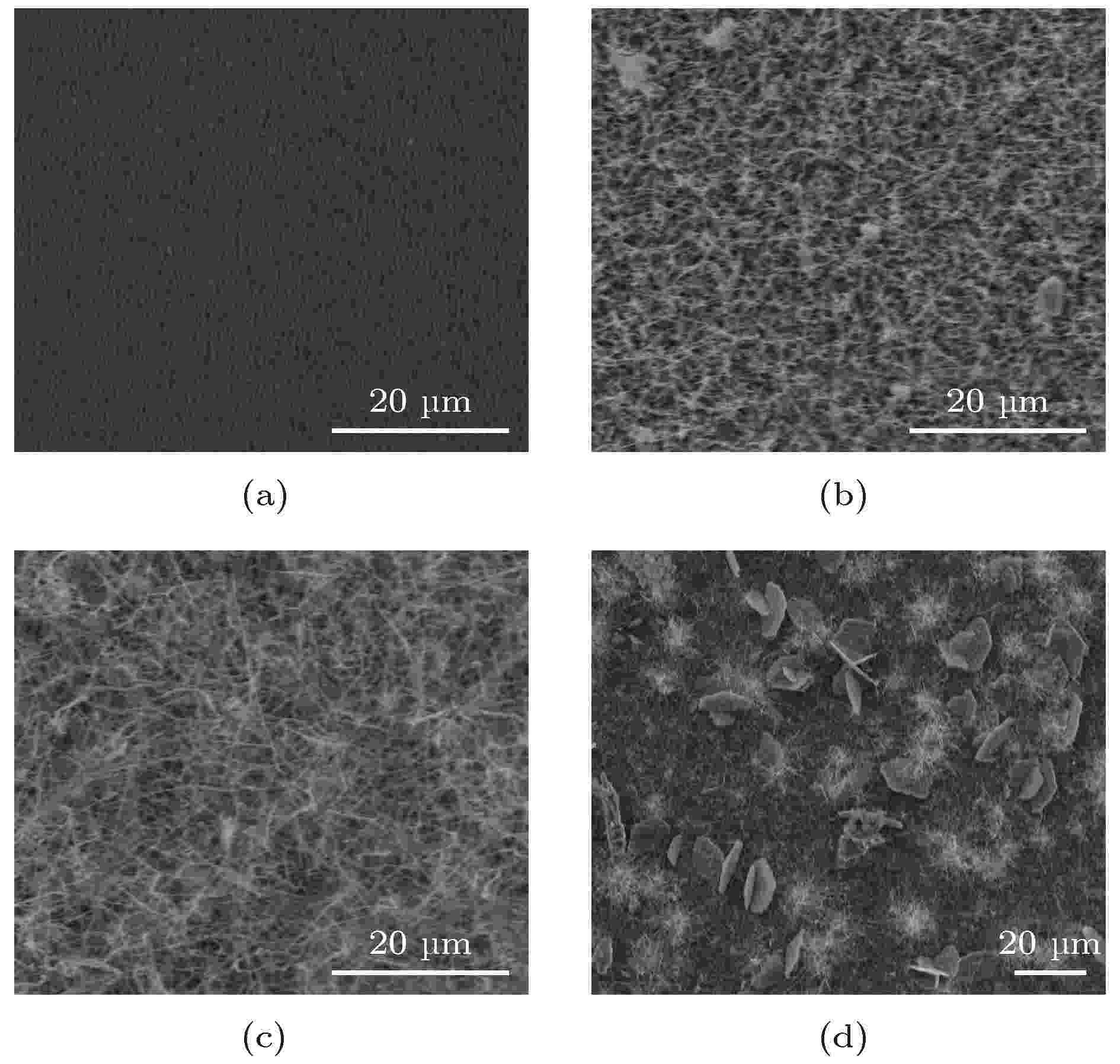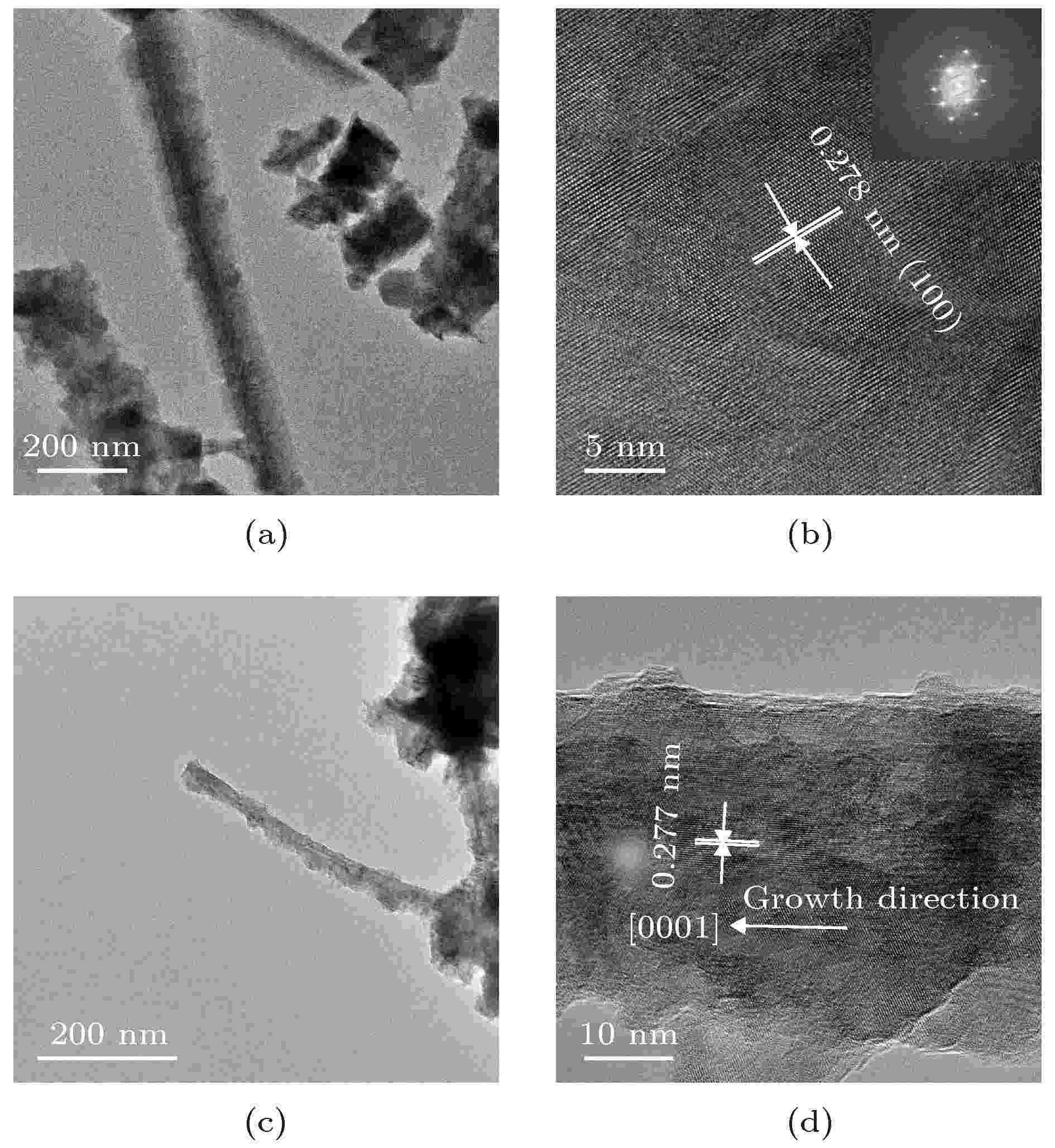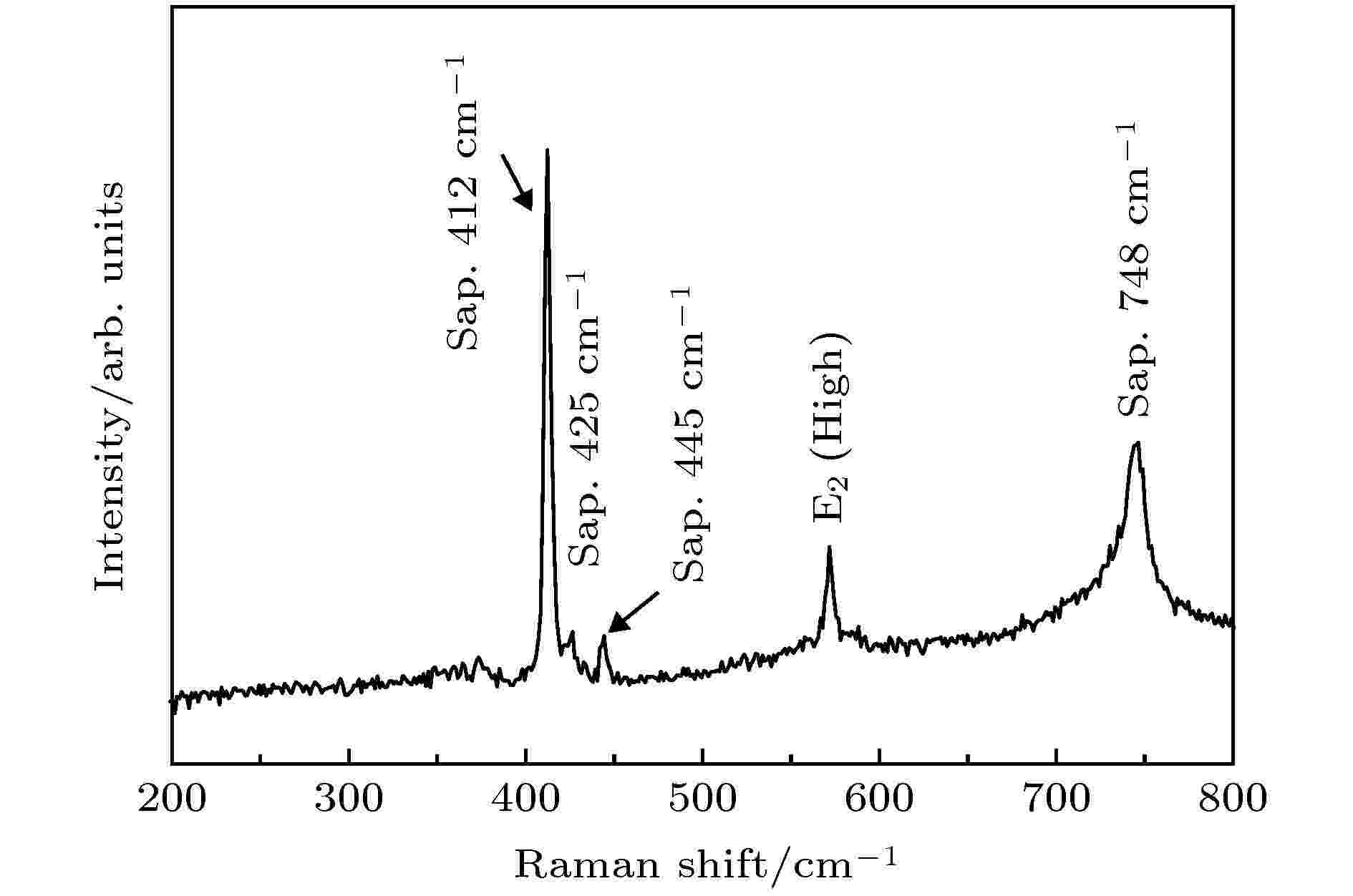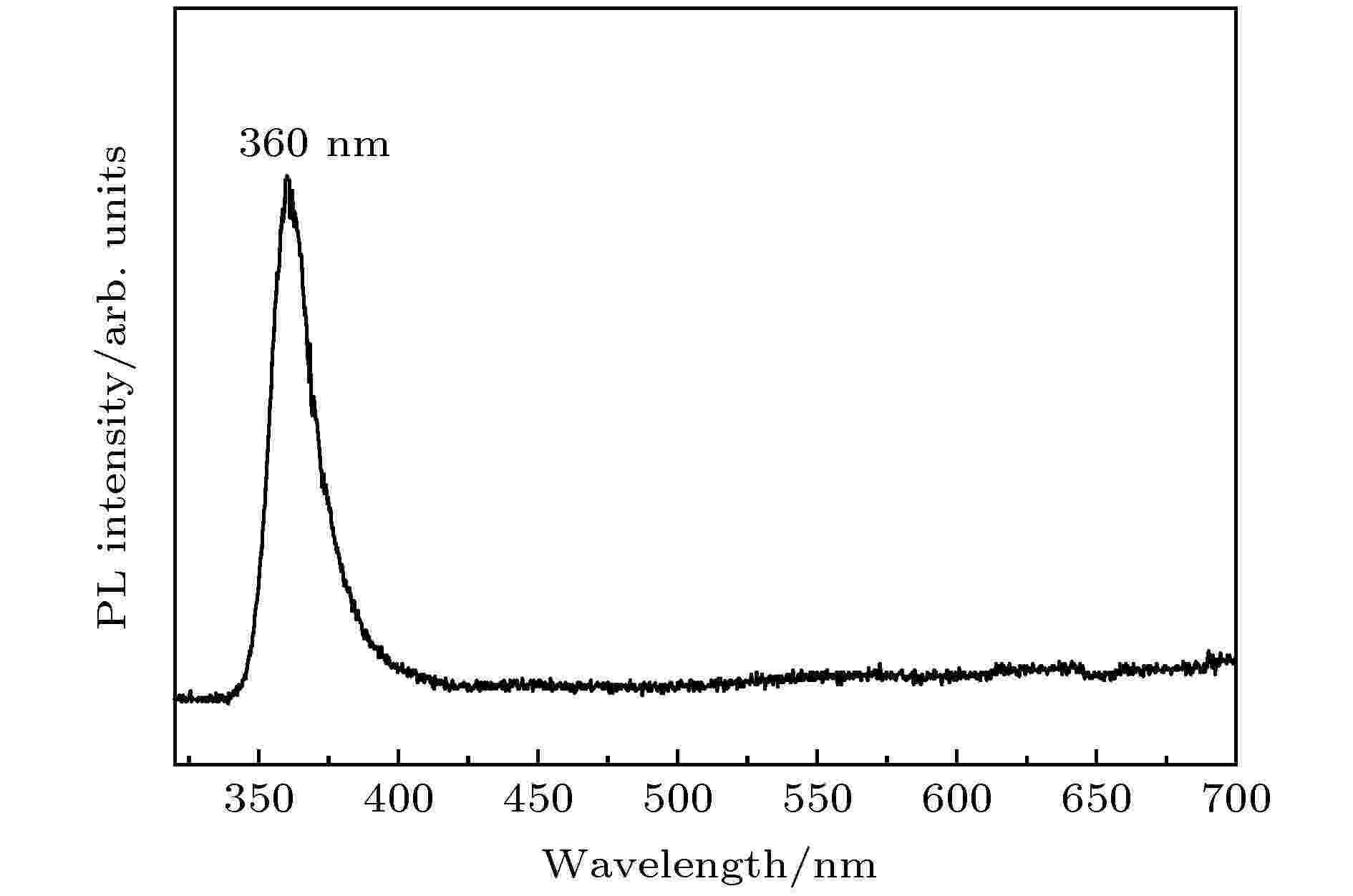全文HTML
--> --> -->GaN纳米线的生长方法主要是分子束外延法(molecular beam epitaxy, MBE)[6-8]和化学气相沉积法, 如金属有机化学气相沉积法(metal-organica chemical vapor deposition, MOCVD)[9]、等离子增强化学气相沉积法(plasmaenhancedchemi-calvapor deposition, PECVD)[10-12]、简单化学气相沉积法(chemical vapor deposition, CVD)[13-15]等. 在这些制备方法之中, 广大****采用金属催化剂来制备GaN纳米线, 例如: Li等[16]采用蓝宝石衬底(放置于原料的下风口), Au为催化剂, Ga2O3混合C粉作为镓源, 通入NH3, 1050 ℃下反应4 h获得了存在表面缺陷的GaN纳米线; 赵军伟等[17]采用Si为衬底, Au为催化剂, Ga2O3混合C粉作为镓源, 通入N2和H2, 1050 ℃制备获得了GaN纳米线; Zhao等[12]还采用Si衬底, Au催化剂, Ga2O3混合C粉作为镓源, 通入N2和H2, 在900 ℃的低温下制备获得了GaN纳米线; 在此基础上, Ji等[10]探究了H2对GaN纳米线的影响, 在无H2的条件下, 仅采用N2为气源, 制备获得了GaN纳米线. 然而, 采用气-液-固(vapor-liquid-solid, VLS)机制获得的GaN纳米线存在着金属污染, 直接影响GaN纳米线的结晶质量和应用. 因此, 有不少****尝试采用无催化剂的方法生长GaN纳米线, 但都是以MBE[18]和MOCVD[19]方法制备获得, 操作、设备复杂, 且都是采用有毒和腐蚀性的三甲基镓和NH3作为反应气源. 为了简化制备工艺, 避免金属催化剂的不利影响, 最近, Feng等[20]采用石墨为衬底, 清洁的N2为氮源, Ga金属为镓源, 以简单的PECVD法无催化剂制备了多晶GaN纳米线. 但以石墨为衬底, GaN与石墨的晶格失配度大, 导致获得的GaN纳米线缺陷较多, 光致发光峰难以调控. 此外, 采用导电衬底制备GaN纳米线, 无法直接应用于光电子器件. 对此, 通过绿色PECVD法, 采用失配度较小、不导电的Al2O3作为衬底无催化剂生长GaN纳米材料, 以期提高GaN的结晶质量和光学性能, 简化器件制备工艺, 该方法迄今还未有人报道.
本文以Al2O3为衬底, 清洁的N2为氮源, Ga金属为镓源, 采用PECVD法无催化剂首次制备获得了GaN纳米线; 同时, 还研究了不同温度和反应时间条件下的GaN纳米结构, 并探讨了GaN纳米线的生长机理. 获得的GaN纳米线具有良好的结晶质量和光致发光性能, 可应用于紫外激光发射器和发光二极管等光电子器件.
采用D8 Advance型X射线衍射(X-ray diffraction, XRD)仪分析对所有样品进行物相分析, 靶材为Cu靶 (λ = 0.154178 nm). 采用Quanta 250型扫描电镜(scanning electron microscope, SEM)进行表面形貌观察. 采用JEM-2100F场发射透射电镜(transmission electron microscope, TEM)对样品进行微观结构观察. 采用Hitachi F-7000型光致发光光谱(photoluminescence, PL)仪测试样品的光学性能, He-Cd激光器为激光光源, 激发波长为325 nm, 测试温度为室温. 采用Renishaw型拉曼(Raman)光谱仪测试样品的拉曼图谱, 激光器波长为532 nm.
3.1.XRD分析
图1为950 ℃和1000 ℃下获得样品的XRD图. 对比氮化镓的XRD标准PDF卡片(JCPDS 50-0792), 从图1中可以观察到, XRD图谱中的所有衍射峰均属于纤锌矿六方相GaN, 对应的晶面分别为(100), (002), (101), (102)和(110), 且没有观察到其他物相衍射峰存在, 说明反应温度为950—1000 ℃时, 获得样品的物相均为纤锌矿六方相GaN. 图 1 950 ℃和1000 ℃下获得样品的XRD图(反应时间为2 h)
图 1 950 ℃和1000 ℃下获得样品的XRD图(反应时间为2 h)Figure1. X-ray diffraction patterns of the samples fabricated at 950 ℃ and 1000 ℃ (Reaction time is 2 h)
2
3.2.SEM分析
图2(a)—图2(c)为不同反应时间获得GaN样品的SEM图(反应温度为1000 ℃). 图2(a)为反应0.5 h获得GaN样品的SEM图. 如图2(a)所示, 氧化铝衬底上生成了高密度的GaN纳米小岛. 当反应时间延长至1 h时, 获得了GaN纳米线, 长度为8—10 μm左右, 如图2(b). 当反应温度增加为2 h时, GaN纳米线的长度为10—20 μm. 实验结果表明, 随着反应时间的增加, GaN纳米线长度增加. 图2(d)为950 ℃反应获得GaN样品的SEM图. 从图2(d)观察到均匀分布的六边形GaN微米片, 大小为15 μm左右. 图 2 反应温度为1000 ℃时, 不同反应时间获得GaN样品的SEM图 (a) 0.5 h, (b) 1 h, (c) 2 h; (d) 950 ℃下获得GaN样品的SEM图
图 2 反应温度为1000 ℃时, 不同反应时间获得GaN样品的SEM图 (a) 0.5 h, (b) 1 h, (c) 2 h; (d) 950 ℃下获得GaN样品的SEM图Figure2. SEM images of GaN samples fabricated at different reaction time (Reaction temperature is 1000 ℃): (a) 0.5 h, (b) 1 h, (c) 2 h; (d) SEM image of GaN sample fabricated at 950 ℃.
2
3.3.TEM分析
图3为1000 ℃反应2 h获得GaN纳米线的TEM图. 图3(a)为单根GaN纳米线的微观形貌图, 直径为100 nm左右. 图3(b)为图3(a)中单根纳米线的高倍透射和反傅里叶变换图, 图中结果表明, GaN纳米线为单晶六方纤锌矿结构, 晶面间距为0.278 nm的晶面对应于六方相GaN的(100)面[21]. 图3(c)为另一根GaN纳米线的微观形貌图, 直径为30 nm左右. 图3(d)为图3(c)中单根GaN纳米线的高倍透射图, 0.277 nm的晶面间距对应于GaN的(100)面[11], 则说明纳米线的生长方向为[0001], 是垂直于[100]的[22]. 图 3 1000 ℃反应2 h获得GaN纳米线的TEM图 (a) 单根GaN纳米线的TEM照片; (b) 图(a)中的GaN纳米线的高倍TEM照片; (c) 另一根GaN纳米线的TEM照片; (d) 图(c)中的GaN纳米线的高倍TEM照片
图 3 1000 ℃反应2 h获得GaN纳米线的TEM图 (a) 单根GaN纳米线的TEM照片; (b) 图(a)中的GaN纳米线的高倍TEM照片; (c) 另一根GaN纳米线的TEM照片; (d) 图(c)中的GaN纳米线的高倍TEM照片Figure3. TEM images of GaN nanowires fabricated at 1000 ℃ (Reaction time is 2 h): (a) TEM image of single GaN nanowire; (b) HR-TEM image of GaN nanowire in (a); (c) TEM image of another GaN nanowire; (d) HR-TEM image of GaN nanowire in (c).
2
3.4.Raman分析
图4为1000 ℃反应2 h获得GaN纳米线的Raman图谱, 拉曼入射光垂直于氧化铝衬底(0001)面. 如图4所示, 可以观察到Raman光谱中存在GaN的E2 (high)声子散射峰在571.2 cm–1处; 除此之外, 还可以观察到氧化铝衬底的拉曼光谱峰, 分别对应于412, 425, 445和748 cm–1[23]. E2(high)声子散射峰对GaN材料的内应力敏感[24,25]. 当GaN内部存在压应力时, E2(high)声子散射峰蓝移; 当GaN内部存在拉应力时, E2(high)声子散射峰红移[25]. 无应力的GaN块体的E2(high)声子散射峰在567.6 cm–1处, 与之相比, GaN纳米线的E2(high)声子散射峰发生了蓝移, 蓝移大小为3.6 cm–1. 内应力的经验计算公式[26]为 图 4 1000 ℃反应2 h获得GaN纳米线的Raman谱图
图 4 1000 ℃反应2 h获得GaN纳米线的Raman谱图Figure4. Raman spectra of GaN nanowires fabricated at 1000 ℃ (Reaction time is 2 h).
2
3.5.生长机理讨论
与先前采用石墨作为衬底制备出的GaN纳米线生长机制不同, 本工作采用Al2O3为衬底, 与GaN的晶格失配度小; 如图2所示, 不同反应温度获得的GaN形貌发生了变化, 可能是由于原子表面扩散[27]引起. 具体的生长机理示意图如图5所示. 氮等离子体均匀分布于整个腔体, GaN纳米材料的生长主要受到Ga原子表面扩散的影响. 在低温时(950 ℃), 如图5(a)—图5(c), GaN在衬底表面沉积生长, 由于Ga原子扩散能量低, 扩散长度较小[28], Ga原子在无极性的m平面(纳米线和微米片除上平面的其余6个面)聚集, 且平行于低能量的(0001)面, 从而c平面(纳米线和微米片的上平面, 为极性面)开始生长, 最终生长获得了六边形GaN微米片(图2(d)). 当反应温度升高至1000 ℃时, 如图5(d)—图5(f), Ga原子扩散能量增加, 原子有足够的能量扩散至极性(0001)面, 为了维持表面低的能量, 此时主要是m平面生长, 最终获得了沿着[0001]方向生长的GaN纳米线(图2(b)). 同时, c平面也会有略微生长, 体现在GaN纳米线的直径略微增加(图2(a)—图2(c)). 因此, 对于GaN纳米线, 从图2(a)—图2(c)中可以明显看到, 随着反应时间的增加, GaN纳米线在衬底上的形核和生长过程. 图 5 GaN纳米材料的生长机理示意图
图 5 GaN纳米材料的生长机理示意图Figure5. Growth mechanism diagram of GaN nanomaterials.
2
3.6.PL性能
图6为1000 ℃反应2 h获得GaN纳米线的PL图. 从图6中可以观察到一个360 nm的发光峰, 为GaN的本征峰[29], 带隙大小为3.44 eV, 相对于无应力GaN材料的本征峰365 nm, 发生了蓝移, 可能是由于GaN纳米线中的压应力导致[30]. PL发光峰的半高宽(FWHM)为7.5 nm, 发光峰尖锐[23], 且峰单一, 表明GaN纳米线的结晶质量好[31], 该GaN纳米线可应用于紫外激光器. 图 6 1000 ℃反应2 h获得GaN纳米线的PL谱图
图 6 1000 ℃反应2 h获得GaN纳米线的PL谱图Figure6. PL spectrum of GaN nanowires fabricated at 1000 ℃ (Reaction time is 2 h).
